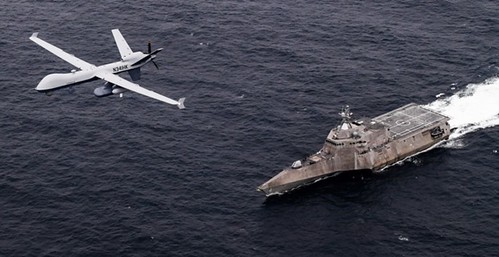Unmanned aerial vehicle Sea Guardian operates with naval assets
SAN DIEGO - The U.S. Navy demonstrated the successful integration of an unmanned maritime surveillance aircraft system with manned capabilities during the Unmanned Systems Integrated Battle Problem 21 (UxS IBP 21) off the coast of San Diego, April 21.
The unmanned MQ-9B Sea Guardian operated in conjunction with a guided-missile cruiser, executing long-range, over-the-horizon targeting. Using sonobuoys and other assets, the Sea Guardian identified contacts and reported locations remotely to the commander on board the cruiser.
"The integration between unmanned and manned capabilities shown today provides an operations approach to strengthening our manned-unmanned teaming," said Rear Adm. James A. Aiken, UxS IBP 21 tactical commander. "Putting our newest technology into our Sailors' hands directly enhances our fleet."
Operational synchronization between unmanned capabilities and traditional manned naval assets ensures the Navy maintains its technological and warfighting advantage. Sea Guardian enhances the Navy's anti-submarine and anti-surface warfare capabilities, among many others.
UxS IBP 21 is a U.S. Pacific Fleet exercise, executed by U.S. 3rd Fleet, designed to integrate manned and unmanned capabilities into operational scenarios to generate warfighting advantages. The week-long event involves surface, subsurface, and aerial unmanned assets, operating with littoral combat ships, guided-missile destroyers, guided-missile cruisers, submarines and helicopter squadrons.
For more information on UxS IBP 21, please visit https://www.dvidshub.net/UxSIBP21.

